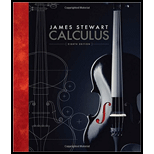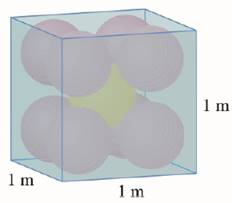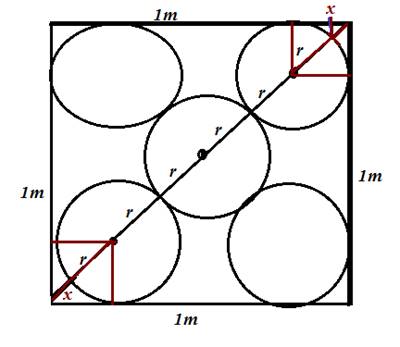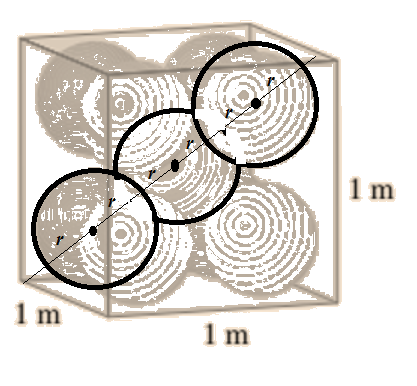
Each edge of a cubical box has length 1 m. The box contains nine spherical balls with the same radius r. The center of one ball is at the center of the cube and it touches the other eight balls. Each of the other eight balls touches three sides of the box. Thus the balls are tightly packed in the box (see the figure). Find r. (If you have trouble with this problem, read about the problem-solving strategy entitled Use Analogy on page 98.)

To find:
The radius
Answer to Problem 1P
Solution:
The radius of each ball is
Explanation of Solution
1) Concept:
We create an analogous problem in two dimensions and use the strategy in two dimension to solve the problem in three dimension.
2) Calculation:
Since three dimensional situations are often diffucult to visualize and work with, we create an analogous problem in two dimensions and use the strategy in two dimension to solve the problem in three dimension.
Let us try to find the analogous problem in two dimensions. The analogue of a cube is a square, and the analogue of a sphere is a circle.Thus, a simillar problem in two dimensions is as follows:
What is r, if five circles with the same radius r are contained in a square of side 1m so that the circles touch each other and four of the circles touch two sides of square, as shown in the figure,

By pythagorean Theorem, the diagonal of the square is
Also from the figure, the diagonal of the square is
Therefore,
But,
Therefore,
Therefore,
That is,
Therefore,
Let’s use this idea to solve the original three dimensional problem.

The diagonal of the cube is
And the diagonal of the cube is also
Therefore,
where
Therefore,
Therefore,
That is,
Therefore,
By rationalization,
Therefore, the radius of each ball is
Conclusion:
The radius of each ball is
Want to see more full solutions like this?
Chapter 12 Solutions
Bundle: Calculus, Loose-Leaf Version, 8th + WebAssign Printed Access Card for Stewart's Calculus, 8th Edition, Multi-Term
- How does a fourier transform works?arrow_forwardDetermine the radius of convergence of a power series:12.6.5, 12.6.6, 12.6.7, 12.6.8Hint: Use Theorem12.5.1 and root test, ratio test, integral testarrow_forwardCan you answer this question and give step by step and why and how to get it. Can you write it (numerical method)arrow_forward
- Can you answer this question and give step by step and why and how to get it. Can you write it (numerical method)arrow_forwardThere are three options for investing $1150. The first earns 10% compounded annually, the second earns 10% compounded quarterly, and the third earns 10% compounded continuously. Find equations that model each investment growth and use a graphing utility to graph each model in the same viewing window over a 20-year period. Use the graph to determine which investment yields the highest return after 20 years. What are the differences in earnings among the three investment? STEP 1: The formula for compound interest is A = nt = P(1 + − − ) n², where n is the number of compoundings per year, t is the number of years, r is the interest rate, P is the principal, and A is the amount (balance) after t years. For continuous compounding, the formula reduces to A = Pert Find r and n for each model, and use these values to write A in terms of t for each case. Annual Model r=0.10 A = Y(t) = 1150 (1.10)* n = 1 Quarterly Model r = 0.10 n = 4 A = Q(t) = 1150(1.025) 4t Continuous Model r=0.10 A = C(t) =…arrow_forwardUse a graphing utility to find the point of intersection, if any, of the graphs of the functions. Round your result to three decimal places. (Enter NONE in any unused answer blanks.) y = 100e0.01x (x, y) = y = 11,250 ×arrow_forward
- 5. For the function y-x³-3x²-1, use derivatives to: (a) determine the intervals of increase and decrease. (b) determine the local (relative) maxima and minima. (e) determine the intervals of concavity. (d) determine the points of inflection. (e) sketch the graph with the above information indicated on the graph.arrow_forwardCan you solve this 2 question numerical methodarrow_forward1. Estimate the area under the graph of f(x)-25-x from x=0 to x=5 using 5 approximating rectangles Using: (A) right endpoints. (B) left endpoints.arrow_forward
- 9. Use fundamental theorem of calculus to find the derivative d a) *dt sin(x) b)(x)√1-2 dtarrow_forward3. Evaluate the definite integral: a) √66x²+8dx b) x dx c) f*(2e* - 2)dx d) √√9-x² e) (2-5x)dx f) cos(x)dx 8)²₁₂√4-x2 h) f7dx i) f² 6xdx j) ²₂(4x+3)dxarrow_forward2. Consider the integral √(2x+1)dx (a) Find the Riemann sum for this integral using right endpoints and n-4. (b) Find the Riemann sum for this same integral, using left endpoints and n=4arrow_forward

 Elementary Linear Algebra (MindTap Course List)AlgebraISBN:9781305658004Author:Ron LarsonPublisher:Cengage Learning
Elementary Linear Algebra (MindTap Course List)AlgebraISBN:9781305658004Author:Ron LarsonPublisher:Cengage Learning Holt Mcdougal Larson Pre-algebra: Student Edition...AlgebraISBN:9780547587776Author:HOLT MCDOUGALPublisher:HOLT MCDOUGAL
Holt Mcdougal Larson Pre-algebra: Student Edition...AlgebraISBN:9780547587776Author:HOLT MCDOUGALPublisher:HOLT MCDOUGAL- Algebra & Trigonometry with Analytic GeometryAlgebraISBN:9781133382119Author:SwokowskiPublisher:Cengage
 Trigonometry (MindTap Course List)TrigonometryISBN:9781337278461Author:Ron LarsonPublisher:Cengage Learning
Trigonometry (MindTap Course List)TrigonometryISBN:9781337278461Author:Ron LarsonPublisher:Cengage Learning Glencoe Algebra 1, Student Edition, 9780079039897...AlgebraISBN:9780079039897Author:CarterPublisher:McGraw Hill
Glencoe Algebra 1, Student Edition, 9780079039897...AlgebraISBN:9780079039897Author:CarterPublisher:McGraw Hill





